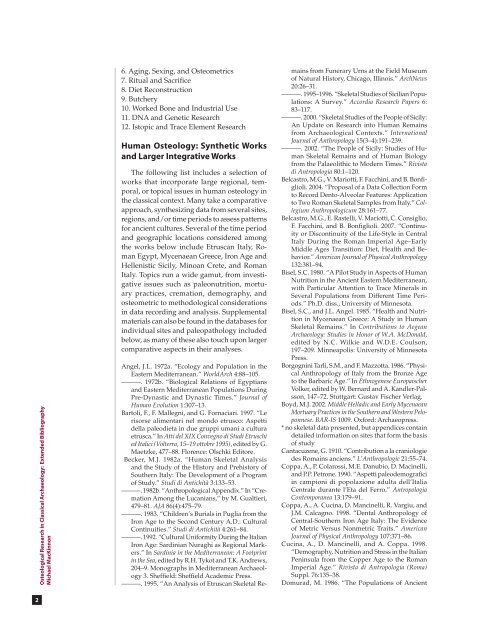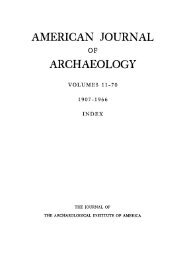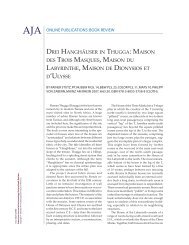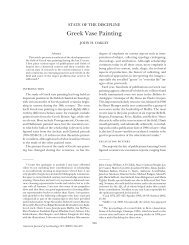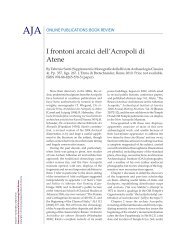AJA Online PublicatiOns - American Journal of Archaeology
AJA Online PublicatiOns - American Journal of Archaeology
AJA Online PublicatiOns - American Journal of Archaeology
You also want an ePaper? Increase the reach of your titles
YUMPU automatically turns print PDFs into web optimized ePapers that Google loves.
Osteological Research in Classical <strong>Archaeology</strong>: Extended Bibliography<br />
Michael MacKinnon<br />
6. Aging, Sexing, and Osteometrics<br />
7. Ritual and Sacrifice<br />
8. Diet Reconstruction<br />
9. Butchery<br />
10. Worked Bone and Industrial Use<br />
11. DNA and Genetic Research<br />
12. Istopic and Trace Element Research<br />
Human Osteology: Synthetic Works<br />
and Larger Integrative Works<br />
The following list includes a selection <strong>of</strong><br />
works that incorporate large regional, temporal,<br />
or topical issues in human osteology in<br />
the classical context. Many take a comparative<br />
approach, synthesizing data from several sites,<br />
regions, and/or time periods to assess patterns<br />
for ancient cultures. Several <strong>of</strong> the time period<br />
and geographic locations considered among<br />
the works below include Etruscan Italy, Roman<br />
Egypt, Mycenaean Greece, Iron Age and<br />
Hellenistic Sicily, Minoan Crete, and Roman<br />
Italy. Topics run a wide gamut, from investigative<br />
issues such as paleonutrition, mortuary<br />
practices, cremation, demography, and<br />
osteometric to methodological considerations<br />
in data recording and analysis. Supplemental<br />
materials can also be found in the databases for<br />
individual sites and paleopathology included<br />
below, as many <strong>of</strong> these also touch upon larger<br />
comparative aspects in their analyses.<br />
Angel, J.L. 1972a. “Ecology and Population in the<br />
Eastern Mediterranean.” WorldArch 4:88–105.<br />
———. 1972b. “Biological Relations <strong>of</strong> Egyptians<br />
and Eastern Mediterranean Populations During<br />
Pre-Dynastic and Dynastic Times.” <strong>Journal</strong> <strong>of</strong><br />
Human Evolution 1:307–13.<br />
Bartoli, F., F. Mallegni, and G. Fornaciari. 1997. “Le<br />
risorse alimentari nel mondo etrusco: Aspetti<br />
della paleodieta in due gruppi umani a cultura<br />
etrusca.” In Atti del XIX Convegno di Studi Etruschi<br />
ed Italici (Volterra, 15–19 ottobre 1995), edited by G.<br />
Maetzke, 477–88. Florence: Olschki Editore.<br />
Becker, M.J. 1982a. “Human Skeletal Analysis<br />
and the Study <strong>of</strong> the History and Prehistory <strong>of</strong><br />
Southern Italy: The Development <strong>of</strong> a Program<br />
<strong>of</strong> Study.” Studi di Antichità 3:133–53.<br />
———. 1982b. “Anthropological Appendix.” In “Cremation<br />
Among the Lucanians,” by M. Gualtieri,<br />
479–81. <strong>AJA</strong> 86(4):475–79.<br />
———. 1983. “Children’s Burials in Puglia from the<br />
Iron Age to the Second Century A.D.: Cultural<br />
Continuities.” Studi di Antichità 4:261–84.<br />
———. 1992. “Cultural Uniformity During the Italian<br />
Iron Age: Sardinian Nuraghi as Regional Markers.”<br />
In Sardinia in the Mediterranean: A Footprint<br />
in the Sea, edited by R.H. Tykot and T.K. Andrews,<br />
204–9. Monographs in Mediterranean <strong>Archaeology</strong><br />
3. Sheffield: Sheffield Academic Press.<br />
———. 1995. “An Analysis <strong>of</strong> Etruscan Skeletal Re-<br />
mains from Funerary Urns at the Field Museum<br />
<strong>of</strong> Natural History, Chicago, Illinois.” ArchNews<br />
20:26–31.<br />
———. 1995–1996. “Skeletal Studies <strong>of</strong> Sicilian Populations:<br />
A Survey.” Accordia Research Papers 6:<br />
83–117.<br />
———. 2000. “Skeletal Studies <strong>of</strong> the People <strong>of</strong> Sicily:<br />
An Update on Research into Human Remains<br />
from Archaeological Contexts.” International<br />
<strong>Journal</strong> <strong>of</strong> Anthropology 15(3–4):191–239.<br />
———. 2002. “The People <strong>of</strong> Sicily: Studies <strong>of</strong> Human<br />
Skeletal Remains and <strong>of</strong> Human Biology<br />
from the Palaeolithic to Modern Times.” Rivista<br />
di Antropologia 80:1–120.<br />
Belcastro, M.G., V. Mariotti, F. Facchini, and B. Bonfiglioli.<br />
2004. “Proposal <strong>of</strong> a Data Collection Form<br />
to Record Dento-Alveolar Features: Application<br />
to Two Roman Skeletal Samples from Italy.” Collegium<br />
Anthropologicum 28:161–77.<br />
Belcastro, M.G., E. Rastelli, V. Mariotti, C. Consiglio,<br />
F. Facchini, and B. Bonfiglioli. 2007. “Continuity<br />
or Discontinuity <strong>of</strong> the Life-Style in Central<br />
Italy During the Roman Imperial Age–Early<br />
Middle Ages Transition: Diet, Health and Behavior.”<br />
<strong>American</strong> <strong>Journal</strong> <strong>of</strong> Physical Anthropology<br />
132:381–94.<br />
Bisel, S.C. 1980. “A Pilot Study in Aspects <strong>of</strong> Human<br />
Nutrition in the Ancient Eastern Mediterranean,<br />
with Particular Attention to Trace Minerals in<br />
Several Populations from Different Time Periods.”<br />
Ph.D. diss., University <strong>of</strong> Minnesota.<br />
Bisel, S.C., and J.L. Angel. 1985. “Health and Nutrition<br />
in Mycenaean Greece: A Study in Human<br />
Skeletal Remains.” In Contributions to Aegean<br />
<strong>Archaeology</strong>: Studies in Honor <strong>of</strong> W.A. McDonald,<br />
edited by N.C. Wilkie and W.D.E. Coulson,<br />
197–209. Minneapolis: University <strong>of</strong> Minnesota<br />
Press.<br />
Borgognini Tarli, S.M., and F. Mazzotta. 1986. “Physical<br />
Anthropology <strong>of</strong> Italy from the Bronze Age<br />
to the Barbaric Age.” In Ethnogenese Europaischer<br />
Volker, edited by W. Bernard and A. Kandler-Palsson,<br />
147–72. Stuttgart: Gustav Fischer Verlag.<br />
Boyd, M.J. 2002. Middle Helladic and Early Mycenaean<br />
Mortuary Practices in the Southern and Western Peloponnese.<br />
BAR-IS 1009. Oxford: Archaeopress.<br />
* no skeletal data presented, but appendices contain<br />
detailed information on sites that form the basis<br />
<strong>of</strong> study<br />
Cantacuzene, G. 1910. “Contribution a la craniologie<br />
des Romains anciens.” L’Anthropologie 21:55–74.<br />
Coppa, A., P. Colarossi, M.E. Danubio, D. Macinelli,<br />
and P.P. Petrone. 1990. “Aspetti paleodemografici<br />
in campioni di popolazione adulta dell’Italia<br />
Centrale durante l’Eta del Ferro.” Antropologia<br />
Contemporanea 13:179–91.<br />
Coppa, A., A. Cucina, D. Mancinelli, R. Vargiu, and<br />
J.M. Calcagno. 1998. “Dental Anthropology <strong>of</strong><br />
Central-Southern Iron Age Italy: The Evidence<br />
<strong>of</strong> Metric Versus Nonmetric Traits.” <strong>American</strong><br />
<strong>Journal</strong> <strong>of</strong> Physical Anthropology 107:371–86.<br />
Cucina, A., D. Mancinelli, and A. Coppa. 1998.<br />
“Demography, Nutrition and Stress in the Italian<br />
Peninsula from the Copper Age to the Roman<br />
Imperial Age.” Rivista di Antropologia (Roma)<br />
Suppl. 76:135–38.<br />
Domurad, M. 1986. “The Populations <strong>of</strong> Ancient


